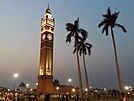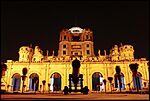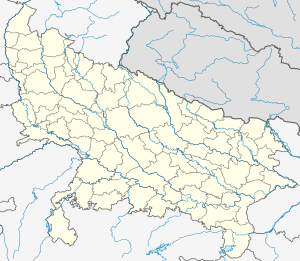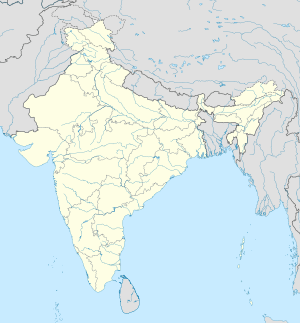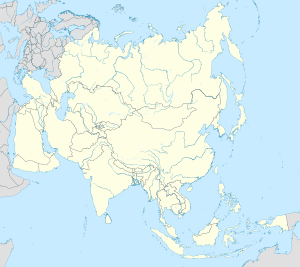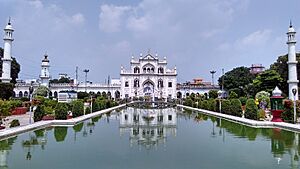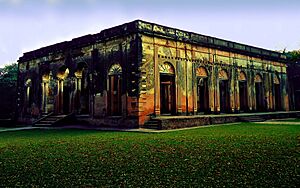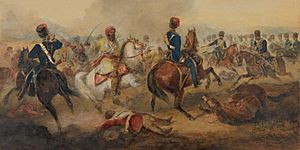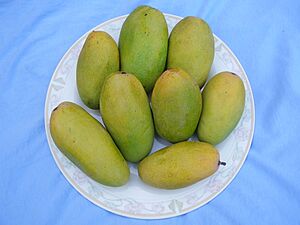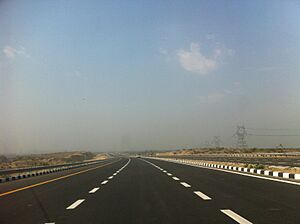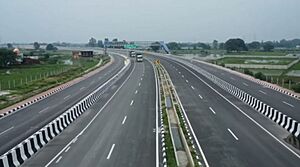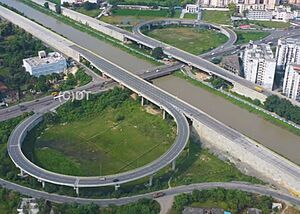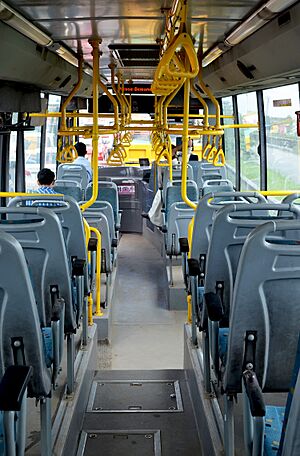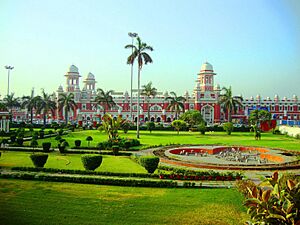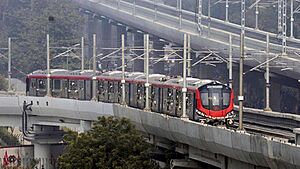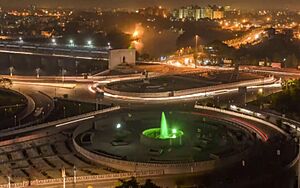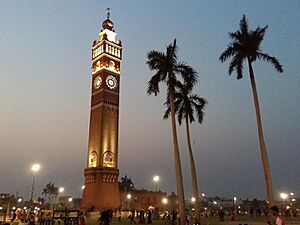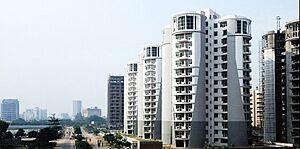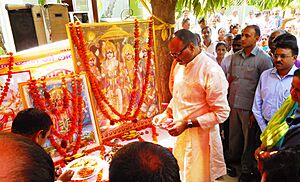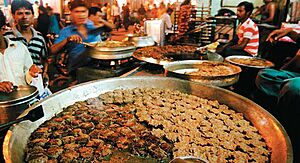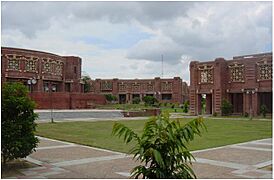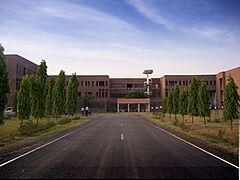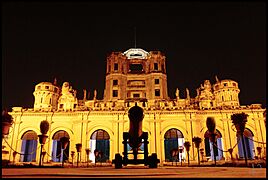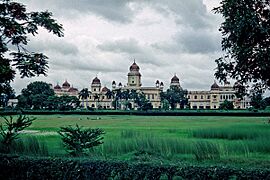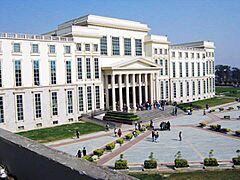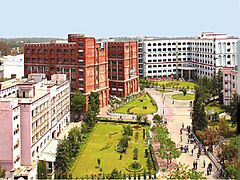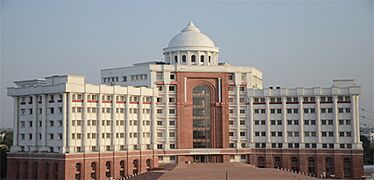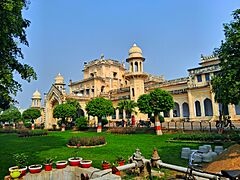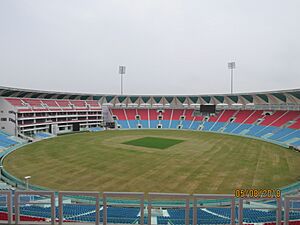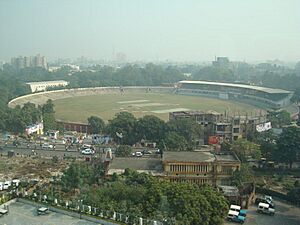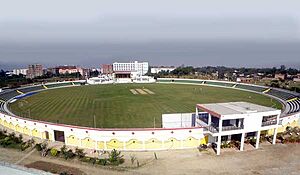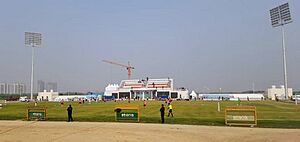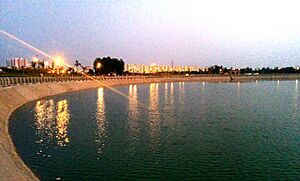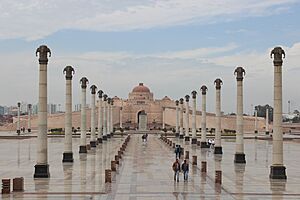Lucknow facts for kids
Quick facts for kids
Lucknow
Lakhnaū
|
||
|---|---|---|
|
Rumi Gate (Turkish Gate)
Chota Imambara
Bara Imambara
Hussainabadi Clock Tower
La Martinière College
Charbagh Railway Station
Ambedkar Memorial Park
Darul Uloom Nadwatul Ulama
Hazratganj Market (Downtown)
Vidhan Bhavan
|
||
|
||
| Nickname(s):
The City of Lakshmana, The City of Nawabs, The Golden City of India, Constantinople of the East, Shiraz-e-Hind
|
||
| Country | ||
| State | ||
| Division | Lucknow | |
| District | Lucknow | |
| Named for | Lakshmana | |
| Government | ||
| • Type | Municipal Corporation | |
| • Body | ||
| Area | ||
| • Total | 631 km2 (244 sq mi) | |
| Area rank | 5th in India | |
| Elevation | 123 m (404 ft) | |
| Population | ||
| • Total | 4,000,000 | |
| • Rank | 11th in India | |
| • Density | 6,300/km2 (16,400/sq mi) | |
| Demonym(s) |
|
|
| Language | ||
| • Official | Hindi | |
| • Additional official | Urdu | |
| • Regional | Awadhi | |
| Time zone | UTC+5:30 (IST) | |
| Pincode(s) |
2260xx /2270xx
|
|
| Telephone code | +91-522 | |
| Vehicle registration | UP-32 | |
| GDP Nominal | $16 billion | |
| Percapita | $2, 800 or ₹2.29 lakh | |
| GDP Nominal (Lucknow District) | ₹1,31,200 cr(2022–23) | |
| Sex ratio | 915 ♀/1000 ♂ | |
| Effective literacy rate (2011) | 85.5% | |
| International Cricket Stadium | BRSABV Ekana Cricket Stadium | |
| Rapid Transit | ||
| International Airport | ||
| HDI | ||
Lucknow (/ˈlʌknaʊ/; Hindustani: [ˈləkʰnəuː] Lakhnaū) is the capital and largest city of the Indian state of Uttar Pradesh. It's also the main city for the Lucknow district and Lucknow division. With about 2.8 million people (as of 2011), it's one of India's most populated cities.
Lucknow has always been a city with many different cultures. It grew into a major cultural and artistic center in North India. In the 18th and 19th centuries, it was the main seat of power for the Nawabs. Today, Lucknow is still important for government, education, business, and arts like music and poetry. It's part of the Uttar Pradesh Heritage Arc along with Agra and Varanasi, which helps boost tourism.
Contents
- City Name: Where Did "Lucknow" Come From?
- Lucknow's Journey Through Time
- Lucknow's Location and Surroundings
- Plants and Animals in Lucknow
- Lucknow's Economy and Industries
- How Lucknow is Governed
- Courts and Justice
- City Services
- Getting Around Lucknow
- People and Population
- Lucknow's Amazing Architecture
- Lucknow's Rich Culture
- Education in Lucknow
- Media and Entertainment
- Sports in Lucknow
- Parks and Fun Places
- Sister City
- Historical Places to Visit
- Images for kids
- See also
City Name: Where Did "Lucknow" Come From?
The name "Lucknow" is the English way of saying "Lakhnau." One popular story says the city is named after Lakshmana, a hero from the Hindu epic Ramayana. The legend suggests Lakshmana had a palace here, called Lakshmanapuri (meaning "Lakshmana's city"). Over time, this name changed to Lakhanpur, then Lachhmanpur, and finally Lucknow.
Another idea is that the city was called Lakshmanavati (meaning "fortunate") after Lakshmana. This name then became Lakhanavati, then Lakhnauti, and finally Lakhnau. Some also believe the city's name is linked to Lakshmi, the Hindu goddess of wealth.
There's also a theory that Lucknow was named after a famous architect named Lakhna Ahir. He is said to have built a fort called Qila Lakhna.
Lucknow's Journey Through Time
Lucknow and the Awadh region have a long history. They were ruled by different groups like the Delhi Sultanate, Sharqi Sultanate, Mughal Empire, Nawabs of Awadh, and later the British.
Early Rulers and the Mughals
From 1350 to 1478, Awadh was part of the Sharqi Sultanate. Around 1555, Emperor Humayun made it part of the Mughal Empire. Later, Emperor Jahangir gave land in Awadh to a nobleman, Sheikh Abdul Rahim. He built a place called Machchi Bhawan, which became a center of power for his family, the Sheikhzadas.
The Nawabs of Awadh: A Golden Age
The Nawabs of Lucknow got their name when Lucknow became their capital. This happened during the rule of the third Nawab. The city became a major cultural hub in North India. The Nawabs were known for their fancy lifestyles and for supporting the arts.
Under their rule, music and dance thrived, and many beautiful buildings were constructed. Famous examples include the Bara Imambara, the Chota Imambara, and the Rumi Darwaza. The Nawabs also left behind a special blend of Hindu and Muslim cultures, known as the Ganga-Jamuni Tehzeeb.

British Influence and Control
In 1722, a Persian adventurer named Saadat Ali Khan I became the Nizam (governor) of Awadh. He set up his court in Faizabad, near Lucknow. As the Mughal Empire weakened, many independent kingdoms like Awadh were formed.
The fourth Nawab, Asaf-ud-Daula, moved his court from Faizabad to Lucknow in 1775. This made Lucknow even more important. The British East India Company started to gain more control over the region. In 1801, a treaty made Awadh a "vassal" state, meaning it was controlled by the East India Company. The Nawabs became more like ceremonial kings.

The 1857 Rebellion and Independence
In 1856, the East India Company took direct control of Awadh. The Nawab, Wajid Ali Shah, was exiled. This led to the Indian Rebellion of 1857. Lucknow was a major center of this rebellion. The rebels took control of the state, and it took the British 18 months to win it back. During this time, the British soldiers at the Residency in Lucknow were surrounded by rebel forces in the Siege of Lucknow.
After the rebellion, Awadh returned to British rule. In 1902, it became part of the United Provinces of Agra and Oudh. In 1920, Lucknow became the capital of this province.
Lucknow played a key role in India's fight for independence. Important meetings, like the Indian National Congress session in 1916, happened here. Leaders like Mahatma Gandhi, Jawaharlal Nehru, and Muhammad Ali Jinnah met in Lucknow. The Kakori conspiracy, a famous event involving Indian revolutionaries, also took place near Lucknow.
Finally, on 15 August 1947, Lucknow, along with the rest of India, became independent from Britain. Today, Lucknow is one of the fastest-growing cities in India.
Lucknow's Location and Surroundings
Lucknow's main natural feature is the Gomti River, which flows through the city. The city is in the middle of the Indus-Gangetic Plain. It is surrounded by smaller towns and villages like Malihabad (known for its orchards), Kakori, and Mohanlalganj.
To the east of Lucknow is Barabanki, to the west is Unnao, to the south is Raebareli, and to the north are Sitapur and Hardoi. Lucknow is about 123 metres (404 ft) above sea level. The city's area grew to 631 km2 (244 square miles) in 2019 when 88 villages were added.
Lucknow's Weather
Lucknow has a humid subtropical climate. This means it has cool, dry winters from November to February and hot, dry summers from March to June. Most of the rain falls from July to October due to the southwest monsoon winds.
In winter, the highest temperature is around 25 °C or 77 °F, and the lowest is usually between 3 to 7 °C (37.4 to 44.6 °F). Fog is common in winter. Summers are very hot, with temperatures often reaching 40 to 45 °C (104 to 113 °F).
Lucknow has been ranked as the 4th best "National Clean Air City" in India for cities with over 10 lakh (1 million) people.
| Climate data for Lucknow (Chaudhary Charan Singh International Airport) 1991–2020, extremes 1952–present | |||||||||||||
|---|---|---|---|---|---|---|---|---|---|---|---|---|---|
| Month | Jan | Feb | Mar | Apr | May | Jun | Jul | Aug | Sep | Oct | Nov | Dec | Year |
| Record high °C (°F) | 31.6 (88.9) |
35.9 (96.6) |
41.1 (106.0) |
45.0 (113.0) |
46.5 (115.7) |
47.7 (117.9) |
44.2 (111.6) |
40.4 (104.7) |
40.1 (104.2) |
38.7 (101.7) |
38.0 (100.4) |
29.9 (85.8) |
47.7 (117.9) |
| Mean daily maximum °C (°F) | 21.4 (70.5) |
26.2 (79.2) |
32.2 (90.0) |
38.2 (100.8) |
39.9 (103.8) |
38.3 (100.9) |
34.2 (93.6) |
33.4 (92.1) |
33.4 (92.1) |
32.8 (91.0) |
29.0 (84.2) |
23.6 (74.5) |
31.9 (89.4) |
| Daily mean °C (°F) | 14.0 (57.2) |
18.4 (65.1) |
23.8 (74.8) |
29.6 (85.3) |
32.6 (90.7) |
32.5 (90.5) |
30.0 (86.0) |
29.5 (85.1) |
28.9 (84.0) |
26.0 (78.8) |
20.9 (69.6) |
15.9 (60.6) |
25.2 (77.3) |
| Mean daily minimum °C (°F) | 7.8 (46.0) |
11.0 (51.8) |
15.4 (59.7) |
21.0 (69.8) |
24.8 (76.6) |
26.7 (80.1) |
26.0 (78.8) |
25.6 (78.1) |
24.4 (75.9) |
19.5 (67.1) |
13.3 (55.9) |
8.9 (48.0) |
18.7 (65.7) |
| Record low °C (°F) | −1.0 (30.2) |
0.0 (32.0) |
5.4 (41.7) |
10.9 (51.6) |
17.0 (62.6) |
19.2 (66.6) |
21.5 (70.7) |
21.2 (70.2) |
17.2 (63.0) |
10.0 (50.0) |
3.9 (39.0) |
0.5 (32.9) |
−1.0 (30.2) |
| Average rainfall mm (inches) | 21.6 (0.85) |
14.0 (0.55) |
11.0 (0.43) |
5.5 (0.22) |
24.5 (0.96) |
107.4 (4.23) |
238.5 (9.39) |
241.6 (9.51) |
162.1 (6.38) |
27.9 (1.10) |
2.5 (0.10) |
4.7 (0.19) |
861.4 (33.91) |
| Average rainy days | 1.7 | 1.4 | 1.1 | 0.7 | 2.0 | 5.1 | 11.8 | 10.6 | 7.2 | 1.4 | 0.4 | 0.5 | 43.8 |
| Average relative humidity (%) (at 17:30 IST) | 61 | 49 | 35 | 26 | 32 | 49 | 73 | 77 | 73 | 62 | 59 | 63 | 55 |
| Average dew point °C (°F) | 9 (48) |
12 (54) |
13 (55) |
14 (57) |
19 (66) |
23 (73) |
26 (79) |
26 (79) |
25 (77) |
19 (66) |
14 (57) |
10 (50) |
18 (63) |
| Average ultraviolet index | 5 | 7 | 9 | 11 | 12 | 12 | 12 | 12 | 10 | 8 | 6 | 5 | 9 |
| Source 1: India Meteorological Department Time and Date (dewpoints, 2005-2015) | |||||||||||||
| Source 2: Weather Atlas, Tokyo Climate Center (mean temperatures 1991–2020) | |||||||||||||
Plants and Animals in Lucknow
Lucknow has about 5.66% forest cover. Common trees include shisham, dhak, neem, and mango. Many types of mangoes, especially Dasheri, are grown nearby in Malihabad and exported. Farmers also grow wheat, rice, sugarcane, potatoes, and various vegetables. Flowers like sunflowers and roses are also cultivated. You might see common Indian monkeys in the forests around the city.
The Lucknow Zoo, opened in 1921, is one of India's oldest zoos. It has many animals from Asia and other parts of the world. The zoo also offers fun toy train rides. The city also has a botanical garden with many different plants. Inside, you'll find the Uttar Pradesh State Museum, which displays ancient sculptures.
Lucknow's Economy and Industries
Lucknow's main industries include airplanes, cars, machine tools, and chemicals. It's also famous for its Chikan embroidery. Lucknow is one of the top cities in India by its economic output (GDP). It's a center for research in areas like medicine and handlooms.
The city's economy is growing with new contributions from IT, manufacturing, and biotechnology. Big companies like Tata Consultancy Services and HCL Technologies have offices here. Lucknow is also becoming an important hub for car manufacturing, with plants from companies like Tata Motors.
To help the textile industry, the Indian government has invested money to create a textile business area. There are also plans for a large IT city and a defense industry area, which will create many jobs.
Traditionally, Lucknow was a market town for mangoes, melons, and grains. It's also known for its unique embroidery styles, especially Chikan and Lakhnawi Zardozi. These are very popular and help the city earn money from exports. Chikankari is a delicate hand embroidery that is 400 years old and is still mainly done in Lucknow.
The city is also developing as India's first AI City and a major IT hub. It's also set to manufacture Bramhos Missiles, showing its growing importance in defense.
How Lucknow is Governed
Lucknow is part of the Lucknow division, which has six districts. The Divisional Commissioner of Lucknow, a senior government officer, leads the local government and manages development and law and order. The District Magistrate (DM) of Lucknow is in charge of property records and elections.
City Management
The Lucknow Municipal Corporation manages the city's daily activities. The city's first local government was set up in 1862. The head of the corporation is the mayor, but a municipal commissioner, a senior government officer, handles the day-to-day running of the city. The corporation gets money from property taxes and fees for services like water and waste management.
Police and Safety
Lucknow has a special Police Commissionerate System. The city police are led by a Commissioner of Police. Lucknow is divided into five zones, each with a Deputy Commissioner. The police use high-tech control rooms and CCTV cameras to watch over the city. Lucknow was the first city in India to have over 10,000 CCTV cameras on its roads.
The Lucknow Modern Police Control Room is India's largest "Dial 112" service center. It has many officers to receive emergency calls from all over the state. Lucknow is also home to the "1090 Women Power line," a call center that helps deal with harassment.
Courts and Justice
Lucknow has a branch of the Allahabad High Court. It also has a District & Sessions Court and other special courts. These courts are important for handling legal cases in the city.
City Services
Electricity in Lucknow is supplied by Madhyanchal Power Distribution Corporation Limited. Fire safety services are provided by the Uttar Pradesh Fire Service. The Jal Nigam is responsible for water supply and sewer systems, while the Jal Sansthan handles water connections. The Lucknow Municipal Corporation manages the city's waste.
Getting Around Lucknow
Roads and Highways
Lucknow is connected by major national highways. You can find many ways to get around, including metro trains, taxis, city buses, cycle rickshaws, and auto rickshaws. Many vehicles use CNG to help reduce air pollution.
Bus Services
City Buses
Lucknow's city bus service is run by Lucknow City Transport Services Limited. It has over 260 buses operating on about 35 routes across the city.
Inter-state Buses
The main bus terminal for travel between states is the Dr. Bhimrao Ambedkar Inter-state Bus Terminal (ISBT) in Alambagh. It connects Lucknow to many major cities in Uttar Pradesh and other states like New Delhi and Jaipur.
Railways
Lucknow has several railway stations. The main one is Lucknow Charbagh railway station, known for its grand building. It connects Lucknow to all major cities across India. The city has 14 railway stations in total, all well-connected by local transport.
Air Travel
Lucknow is served by Chaudhary Charan Singh International Airport. It's ranked as one of the best small airports in the world. The airport handles both domestic and international flights to places like Dubai and Bangkok. It's the busiest airport in Uttar Pradesh. Plans are underway to expand the airport to handle even larger planes.
Metro System
The Lucknow Metro is a fast train system that started in 2017. It's known for being one of the fastest-built metro systems in the world. The metro has two main lines: a north-south line and an east-west line, helping to reduce traffic on city roads.
Cycling
Lucknow is becoming a very bicycle-friendly city. Special bike tracks have been built, inspired by cities like Amsterdam. There are plans to create an even bigger network of cycle tracks and offer bike rentals. Lucknow even hosted a national cycling event called 'The Lucknow Cyclothon'.
People and Population
| Historical population | ||
|---|---|---|
| Year | Pop. | ±% |
| 1865 | 300,000 | — |
| 1871 | 284,800 | −5.1% |
| 1881 | 261,300 | −8.3% |
| 1891 | 273,000 | +4.5% |
| 1901 | 264,000 | −3.3% |
| 1911 | 259,800 | −1.6% |
| 1921 | 240,600 | −7.4% |
| 1931 | 274,700 | +14.2% |
| 1941 | 387,177 | +40.9% |
| 1951 | 496,900 | +28.3% |
| 1961 | 595,400 | +19.8% |
| 1968 | 763,600 | +28.2% |
| 1971 | 814,000 | +6.6% |
| 1981 | 1,007,604 | +23.8% |
| 1991 | 1,669,204 | +65.7% |
| 2001 | 2,245,509 | +34.5% |
| 2011 | 2,902,601 | +29.3% |
| Religion in Lucknow City (2011) | ||||
|---|---|---|---|---|
| Religion | Percent | |||
| Hinduism | 71.71% | |||
| Islam | 26.36% | |||
| Sikhism | 0.76% | |||
| Christianity | 0.58% | |||
| Others | 0.59% | |||
In 1981, Lucknow's population grew to over one million people. By 2011, the city had a population of 2,815,601. Of these, 1,470,133 were men and 1,345,468 were women.
In Lucknow, for every 1000 men, there were 915 women in 2011. This is lower than the national average for India. The city has a high literacy rate of 84.72%. Most people in Lucknow speak Hindi (88.16%), while Urdu is spoken by 10.26%.
Lucknow's Amazing Architecture
Lucknow's buildings show many different styles of architecture. Many famous buildings were built during the British and Mughal eras. Most of these historical buildings are in the old part of the city. The Uttar Pradesh Tourism Department even offers a "Heritage Walk" to explore these monuments.
Famous Landmarks
The Bara Imambara in Hussainabad is a huge building constructed in 1784 by Nawab Asaf-ud-Daula. It was built to help people during a terrible famine. It has the largest hall in Asia that doesn't use any external support from wood, iron, or stone beams. About 22,000 workers helped build it!
The 18 m (60 feet) tall Rumi Darwaza, also built by Nawab Asaf-ud-daula in 1784, was once the entrance to Lucknow. It's also called the Turkish Gateway.
You can see various architectural styles in Lucknow's historic areas. The University of Lucknow shows European influence. The Uttar Pradesh Vidhan Sabha building and Charbagh Railway station have an Indo-Saracenic Revival architecture style, which mixes Indian and European designs.
Dilkusha Kothi is what's left of a palace built around 1800. It shows English Baroque architecture and was used as a hunting lodge and summer home by the Nawabs.
The Chattar Manzil was a palace for the rulers of Awadh. Its dome looks like an umbrella, which is why it's called "Chattar" (Hindi for "umbrella").
Another example of mixed styles is La Martiniere College. It blends Indian and European ideas. It was built by Major-General Claude Martin and has domed ceilings without any wooden beams. You can also see hints of Gothic architecture in the college.
Lucknow's architecture, from the grand Imambaras to the colonial-era buildings, tells the story of its rich past. At night, these lit-up monuments become a beautiful sight.
Lucknow's Rich Culture
Lucknow is a city with many cultures and languages. Many of its unique traditions have become famous. The city's culture today is a mix of Hindu and Muslim influences, thanks to the Nawabs of Awadh. They encouraged different traditions to grow together. People from Lucknow are known for their polite and refined way of speaking. They call themselves Lucknowites or Lakhnavi.
Traditional Dress: The Gharara
Lucknow is famous for its ghararas. This is a traditional women's outfit that came from the Nawabs of Awadh. It includes loose trousers with pleats, a shirt (kurta), and a veil (dupatta). It's often decorated with beautiful embroidery using gold or silver threads.
Language and Poetry
While Hindi is the main official language of Uttar Pradesh, most people in Lucknow speak everyday Hindustani. Indian English is also widely used for business. The Urdu language is a big part of Lucknow's culture, especially in poetry. The local dialect is Awadhi, which is still used in rural areas and by some in the city.
Historically, Lucknow was a major center for Muslim culture. Two famous poets, Mir Babar Ali Anis and Mirza Dabeer, were known for their unique elegiac poetry called marsiya. This poetry is about the sacrifice of Imam Husain and is remembered during the annual observance of Muharram.
Delicious Food: Awadhi Cuisine
The Awadh region has its own special Nawabi style of cooking. Chefs here developed amazing skills in cooking food slowly (called Dum style cooking). This led to many delicious dishes like kababs, kormas, biryanis, and different types of breads.
Kebabs are very popular and come in many styles, like kakori and galawati. Tunde ke kabab restaurants are famous for a very soft kebab created by a chef with one arm (Tunday means "one-armed"). People from other cities and countries come to Lucknow just to try these kebabs!
Lucknow is also known for its street food like chaats, kulfi (Indian ice cream), and sweets. Nahari, a mutton dish, is popular among meat-eaters. Sheermal is a sweet bread. Makkhan-malai is a sweet treat made only in winters.
Festivals and Celebrations
Lucknow celebrates many Indian festivals with great enthusiasm, such as Christmas, Diwali, Eid, and Holi.
- Lucknow Mahotsav: This festival is held every year to show off Uttar Pradesh's art and culture and to attract tourists.
- Lucknow Literature Festival: This annual festival, started in 2013, brings together writers and thinkers from around the world.
- Muharram: Lucknow is an important center for Shia Islam. During Muharram, Muslims mourn the memory of Imam Husain. Special processions take place, which started during the time of the Awadh Nawabs.
- Deva Mela: This fair celebrates the anniversary of Sufi saint Haji Waris Ali Shah in Dewa, India, near Lucknow.
- Chup Tazia: This silent mourning procession started in Lucknow and is one of the most important Muharram processions.
- Bada Mangal: Celebrated in May, this festival honors Lord Hanuman. Local people organize fairs and give out free food to everyone, showing the city's mixed culture.
Dance, Drama, and Music
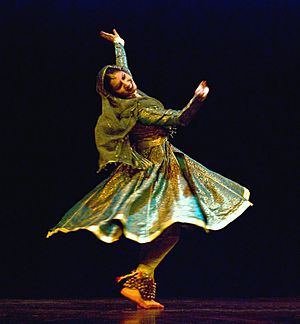
The classical Indian dance form Kathak originated in Lucknow. Wajid Ali Shah, the last Nawab of Awadh, was a big supporter of Kathak. Famous dancers like Birju Maharaj have kept this tradition alive.
Lucknow is also the hometown of the famous ghazal singer Begum Akhtar. The Bhatkande Music Institute University in Lucknow is named after musician Vishnu Narayan Bhatkhande. The Bhartendu Academy of Dramatic Arts (BNA) is a theater training school in Gomti Nagar. Many famous musicians and actors have come from Lucknow.
Lucknow Chikan Embroidery
Lucknow is known for its beautiful embroidery, especially chikankari. This 400-year-old art form was developed in Lucknow and is still practiced here. Chikankari involves delicate hand embroidery using white thread on fine cotton cloth. It's used on caps, kurtas, saris, and scarves. Lucknow is the biggest exporter of chikan embroidered clothes. In 2008, chikankari received special recognition, confirming Lucknow as the main place for its creation.
Quality of Life
Lucknow was ranked "India's second happiest city" in a survey. It scored well in areas like food, transport, and overall citizen happiness, doing better than many other big cities in India.
Education in Lucknow
Lucknow is home to many important educational and research institutions. These include the Indian Institute of Management Lucknow (IIM-L), Indian Institute of Information Technology, Lucknow (IIIT-L), and the Central Drug Research Institute (CDRI).
The city has seven universities, including the University of Lucknow and a technical university. There are also many polytechnics and engineering institutes.
Some of Uttar Pradesh's major schools are in Lucknow, such as Delhi Public School, City Montessori School, and La Martiniere Lucknow.
City Montessori School holds a Guinness World Record for being the largest school in the world, with over 40,000 students. It has also won a UNESCO Prize for Peace Education.
La Martiniere Lucknow, founded in 1845, is one of India's oldest schools and is unique for having been awarded a battle honour. Lucknow also has a sports college called Guru Gobind Singh Sports College.
Media and Entertainment
Lucknow has influenced the Hindi film industry. Many movies have been filmed in Lucknow, using its beautiful locations as a backdrop. Some parts of popular films like Umrao Jaan and Tanu Weds Manu were shot here. The government plans to develop two film cities in Lucknow.
The city has several newspapers, including Hindustan Times and The Times of India. The Pioneer, started in 1865, is one of India's oldest English newspapers.
Lucknow also has many radio stations, including Radio City and Radio Mirchi. An early All India Radio station has been operating in Lucknow since 1938.
Sports in Lucknow
Cricket, football, badminton, golf, and hockey are very popular sports in Lucknow.
The main sports center is the K. D. Singh Babu Stadium. It has a swimming pool and indoor games. The Ekana International Cricket Stadium opened in 2017 and is one of the largest cricket stadiums in India.
Lucknow is the headquarters for the Badminton Association of India. It hosts international badminton competitions like the Syed Modi Grand Prix.
The Lucknow Race Course is a large area for horse racing. The Lucknow Golf Club is located on the grounds of La Martinière College.
Many national and world-class athletes have come from Lucknow, especially cricketers and hockey players. In 2021, an IPL cricket team called Lucknow Super Giants was formed, based in the city.
City Sports Teams
| Club | Sport | Team | Homeground | Founded |
|---|---|---|---|---|
| Uttar Pradesh Cricket Team | Cricket | Ranji Trophy
Vijay Hazare Trophy Syed Musthaq Ali Trophy |
BRSABV Ekana Cricket Stadium | 1934 |
| K.D Singh Babu Stadium | ||||
| Awadhe Warriors | Badminton | Premier Badminton League | Babu Banarasi Das Indoor Stadium | 2015 |
| Uttar Pradesh Wizards | Field hockey | Hockey India League | Major Dhyan Chand Stadium | 2012 |
| Lucknow Super Giants | Cricket | Indian Premier League | BRSABV Ekana Cricket Stadium | 2021 |
| UP Yoddha | Kabaddi | Pro Kabaddi League | Babu Banarasi Das Indoor Stadium | 2017 |
| UP Warriorz | Cricket | Women's Premier League | BRSABV Ekana Cricket Stadium | 2023 |
Parks and Fun Places
Lucknow has many parks and recreation areas. These include the Kukrail Reserve Forest, Qaisar Bagh, and Gomti Riverfront Park.
Janeshwar Mishra Park is one of the largest parks in Asia. It has lots of green space, a human-made lake, and India's longest cycling and jogging track. There are plans to build a giant Ferris wheel there, like the London Eye, to offer great views of the city.
Kukrail Picnic Spot is a crocodile-breeding sanctuary. It also has a small zoo and open spaces, making it a unique place to visit.
Sister City
Historical Places to Visit
- Bara Imambara
- Chhota Imambara
- Imambara Ghufran Ma'ab
- Aminabad
- La Martiniere Lucknow
- Isabella Thoburn College
- Qaisar Bagh
- Rumi Darwaza
- Shah Najaf Imambara
- Dargah of Hazrat Abbas
- Dilkusha Kothi
- Karbala of Dayanat-ud-Daulah
- Tomb of Mir Babar Ali Anis
- Imambara Sibtainabad (Maqbara of Amjad Ali Shah)
- Rauza Kazmain
- Residency
- Usman Enclave
- All Saints Garrison Church, Lucknow
- Alambagh
- Begum Hazrat Mahal Park
Images for kids
See also
 In Spanish: Lucknow para niños
In Spanish: Lucknow para niños





